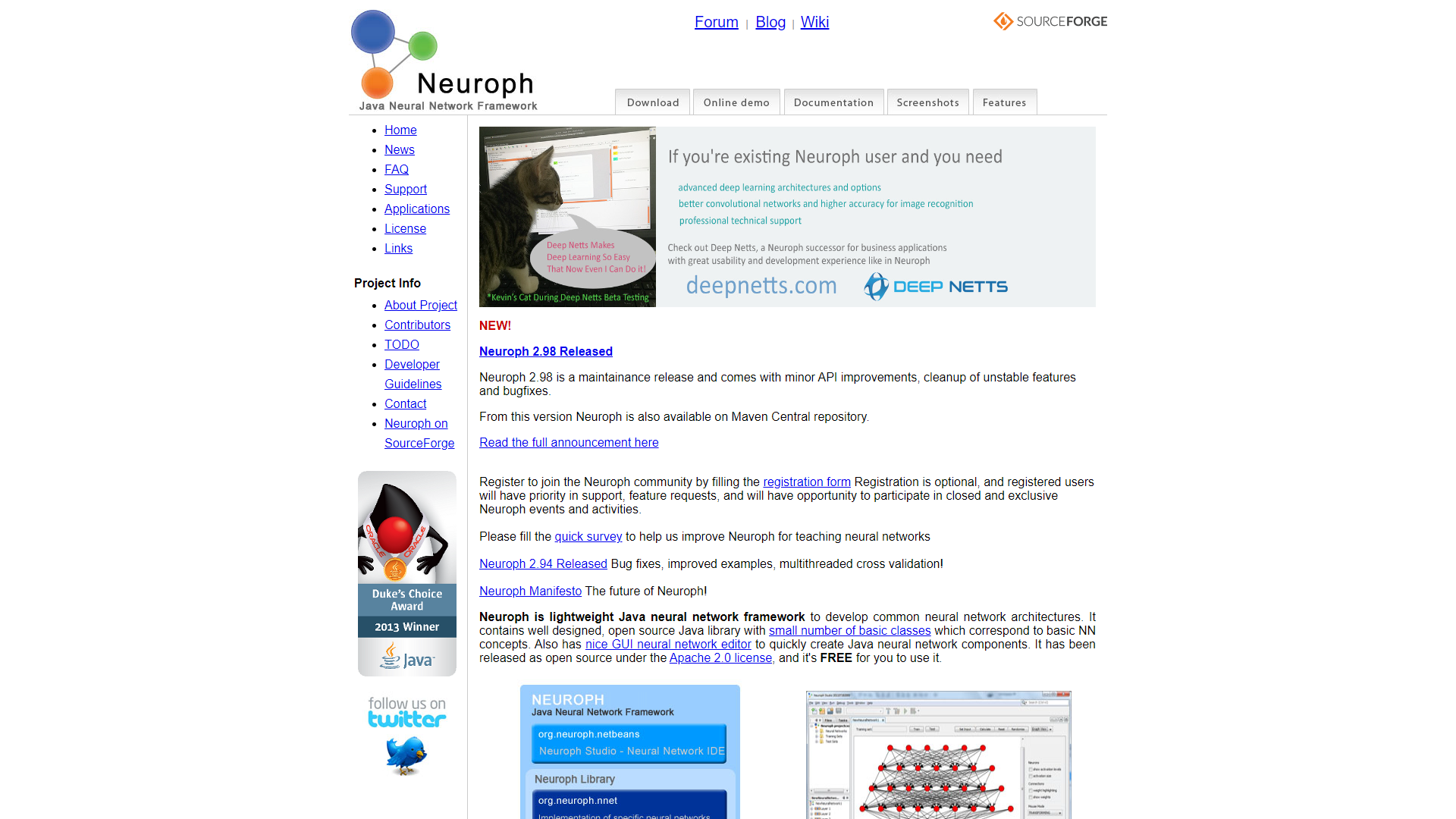
Neuroph
Neuroph is a simple and user-friendly Java library for neural networks.

Overview
Neuroph is an open-source Java framework designed for the development of neural networks. It is intended to make it easier for developers to create and use neural networks in their applications. With its clean API and modular design, Neuroph allows users to quickly set up and train networks with minimal code.
The library is equipped with a range of pre-built neural network types, such as multi-layer perceptrons and convolutional neural networks. This feature helps developers avoid starting from scratch and allows them to focus on building functional applications. Additionally, Neuroph supports multiple learning algorithms, making it versatile for various machine learning tasks.
Neuroph also features an easy-to-use GUI Builder for visualizing and training networks. This interface is beneficial for users who are new to machine learning, as it helps them understand the concepts of neural networks in a hands-on manner. Over the years, Neuroph has gained a loyal user base and continues to be used in both educational and professional settings.
Key features
User-Friendly API
Designed for simplicity, Neuroph makes it easy for developers to implement neural networks without extensive knowledge in AI.
Modular Architecture
The library's modular design allows users to create and customize various types of networks without coding everything from scratch.
GUI Builder
Neuroph's graphical user interface helps users build and train networks visually, making complex processes easier to understand.
Support for Multiple Network Types
Including feedforward, convolutional, and recurrent neural networks, allowing flexibility for various applications.
Learning Algorithms
Neuroph offers various algorithms like backpropagation, perceptron learning, and more to train networks effectively.
Cross-Platform
Being based on Java, Neuroph can run on any platform that supports Java, ensuring broad compatibility.
Open Source
As a free and open-source project, users can contribute to its development and adapt it to their needs.
Active Community
Neuroph has a supportive community, making it easier for new users to find help and resources.
Pros & Cons
Pros
- Easy to Use
- Time-Saving
- Visualization
- Flexibility
- Active Development
Cons
- Limited Documentation
- Java Dependent
- Performance
- Steep Learning Curve
- Less Popular
Rating Distribution
User Reviews
View all reviews on G2Neuroph: Neural Nework Framework
What do you like best about Neuroph?
1. It has the best Java library that too is open source.
2. Java library is well designed with small open classes.
3. Its user interface is easier to use.
4. Creation of Java neural network is quick.
What do you dislike about Neuroph?
1. Despite the user-friendly interface, it is somewhat flawed and shows technical glitches during use.
2. Creation of Java network is not smooth working and lags sometimes.
3. It also consumes more data than any other software that works on the same configuration.
What problems is Neuroph solving and how is that benefiting you?
It provides more intelligence to the computer and makes it smooth and easier to work. It cuts off the labor work and time. So, I find it more efficient to work with
Great multi-layer neural network Java Framework
What do you like best about Neuroph?
- Offer an IDE where one can smoothly configure their neural network.
- Options to choose the learning algorithm of your choice.
What do you dislike about Neuroph?
- Does not support CNN.
- Lacks backward compatibility.
What problems is Neuroph solving and how ...
Amazing Java based Neural Network framework
What do you like best about Neuroph?
It has a nice well desgined Artificial Neural Network framework written in open source Java which is very lightweight with easy-to-use classes for basic NN concepts.
What do you dislike about Neuroph?
There is a lack of backward compatibility, which requires rew...
A java framework to use multi layer neural network
What do you like best about Neuroph?
It provides IDE where we can easily configure our neural network and choose the learning algorithm without worrying about the code. It also offers different types of neural network architecture.
What do you dislike about Neuroph?
It would be great if it started ...
Great Software so far!
What do you like best about Neuroph?
I like how the software allows multiple people to work on it without encountering any glitches.
What do you dislike about Neuroph?
There is nothing I dislike about this software. It is a great platform.
What problems is Neuroph solving and how is that benefitin...
Company Information
Alternative Artificial Neural Network tools
FAQ
Here are some frequently asked questions about Neuroph.
Neuroph is an open-source Java library designed for creating and training neural networks.
Neuroph is suitable for both beginners and experienced developers interested in machine learning.
Yes, Neuroph is an open-source project and can be used for free.
Neuroph is built on Java, allowing it to run on any platform that supports Java.
Yes, Neuroph offers a GUI Builder for users to visually build and train neural networks.
You can create feedforward, convolutional, and recurrent neural networks using Neuroph.
Yes, Neuroph's modular architecture allows you to customize and create different types of networks.
You can visit the official website at http://neuroph.sourceforge.net/ for more information and resources.